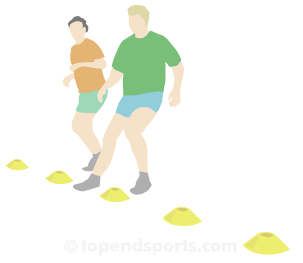The Progressive Aerobic Cardiovascular Endurance Run (PACER) test is a version of the Beep Test, and is part of the FitnessGram and Brockport test batteries. This 15 meter version is the shorter alternative for those who do not have the space to conduct the 20m PACER, and also the choice for 2nd and 3rd grade students. Participants run back and forth over 15m, at speeds which increase approximately every minute.
equipment required: Flat non-slip surface, marking cones, up to 20m measuring tape, PACER test cd, cd player, recording sheets.
pre-test: Explain the test procedures to the subject. Perform screening of health risks and obtain informed consent. Prepare forms and record basic information such as age, height, body weight, gender and test conditions (indoors/outdoors, weather, running surface). Measure and mark out the course. Perform a standard warm-up. See more details of pre-test procedures.
procedure: Two lines a marked out 15 meters apart. The test involves continuous running between the two lines in time to recorded beeps (see details of 15m PACER test levels and speeds). The time between recorded beeps decreases each minute (level) requiring an increase in pace. The speeds are the same as for the 20m PACER - the initial speed is 8.0km/hr, which increases to 9.0 km/hr then by 0.5km/hr each level (approximately every minute). The students continue until they are unable to keep pace with the beeps. They receive a warning the first time they are short of the turning line, and are removed from the test for the second infringement.
 scoring: The score is the total number
of shuttles reached before the student was unable to keep up with
the recording. The test scores can be entered into the FitnessGram software for analysis. To enter the scores into the FitnessGram software there is a conversion chart to convert results from the 15m PACER to a 20m equivalent score.
scoring: The score is the total number
of shuttles reached before the student was unable to keep up with
the recording. The test scores can be entered into the FitnessGram software for analysis. To enter the scores into the FitnessGram software there is a conversion chart to convert results from the 15m PACER to a 20m equivalent score.
target population: The test is suitable for sports teams and school groups of all ages, but not for people in which a maximal exercise test could be considered dangerous.
reliability: Reliability would depend on how strictly the test is run, and the practice allowed for the participants. Several practice trials would be ideal.
advantages: This shorter version is handy for those with limited indoor spaces. Large groups of children can perform this test all at once for minimal costs. Also, the test continues to maximum effort unlike many other tests of endurance capacity.
disadvantages: Practice and motivation levels can influence the score attained, and the scoring can be subjective. As the test is usually conducted outside, the environmental conditions can also affect the results.
comments:
- This test is a maximal test which requires a reasonable level of fitness - care must be taken with students who are sick, of poor fitness or elderly.
- The FitnessGram cd also provides the cadences for the curl-up and push-up portions of the test battery
references:
- Leger LA, Mercier D, Gadoury C, Lambert J. The multistage 20 meter shuttle run test for aerobic fitness. J Sports Sci. 1988; 6:93-101.
- Mahar, M.T., Welk, G.J., Rowe, D.A., Crotts, D.J., & McIver, K.L. (2006). Development and validation of a regression model to estimate VO2peak from PACER 20-m shuttle run performance. Journal of Physical Activity and Health, VOL 3; SUPP/2, pages S34-S46.
- McClain, J., Welk, G.J., Ihmels, M., Schaben, J.W. (2006). Comparison of two versions of the PACER aerobic fitness test. Journal of Physical Activity and Health, VOL 3; SUPP/2, pages S47-S57. also abstract published in Medicine & Science in Sports & Exercise: Volume 36(5) Supplement May 2004 p S5. conclusion: Overall, the results suggest the 15m and 20m PACER protocols provide similar information about aerobic fitness in youth. The 15m PACER protocol provides a useful alternative to the 20m protocol for schools with smaller physical education facilities.
Related Products
- Buy the 20m or 15m PACER test cd — this recording provides pacing for the shuttle run portion of the test as well as audio tracks with the cadences for the curl-up and push-up tests.
- Buy the Fitnessgram/Activitygram Test Manual which includes a DVD with video clips and the PACER test cd.
Similar Tests
- 20m PACER Test
- 15m Bleep Test — a shorter version of the beep test
Related Pages
- The conversion chart to assist converting scores on the 15m PACER to a 20m score.
- Comparision of the PACER Test 15m & 20m Levels and Speeds.
- This test is part of the FitnessGram and Brockport Test battery.
- Guide to Variations of the beep / bleep test
- More Modified Beep Tests
- The complete guide to the beep test for comprehensive information about the beep test.
- Maximizing Your Score — to get the most out of the beep test.


 Current Events
Current Events